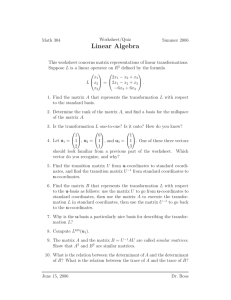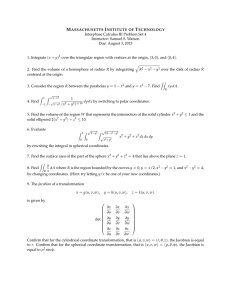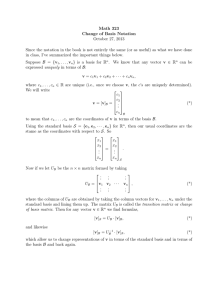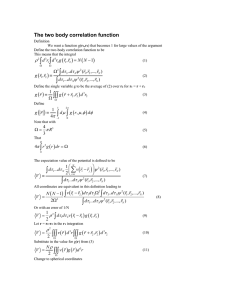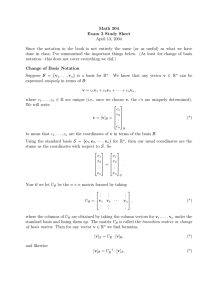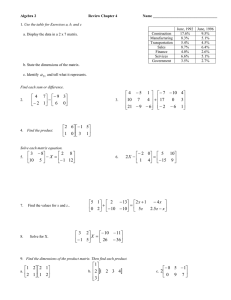Document 11821765
advertisement
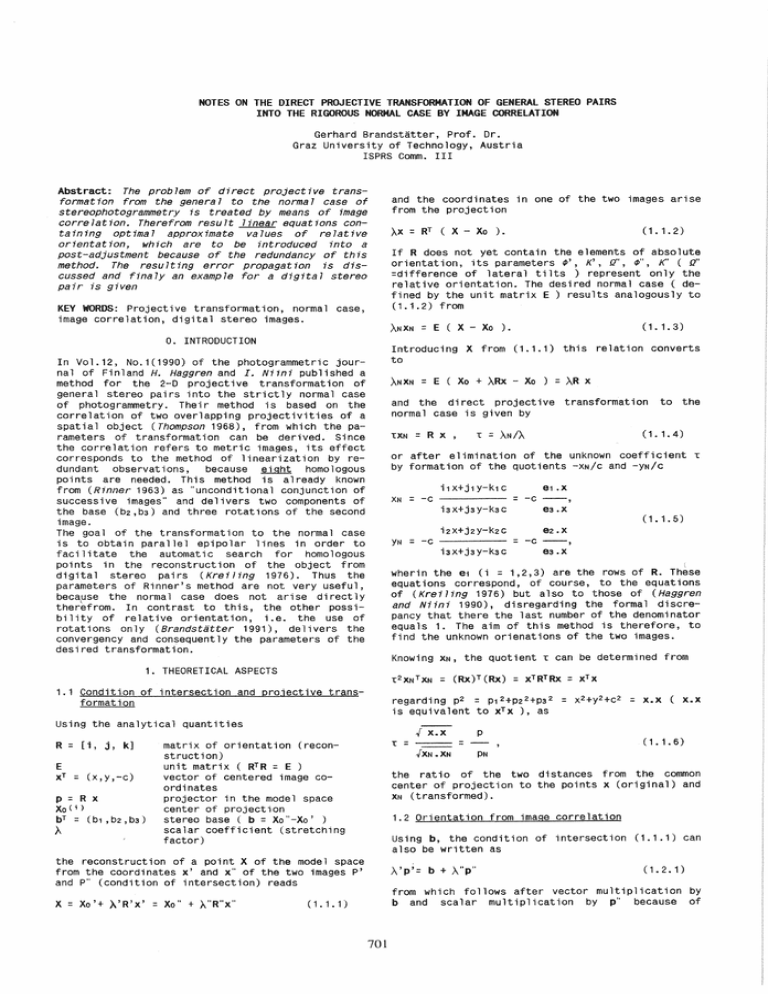
NOTES ON THE DIRECT PROJECTIVE TRANSFORMATION OF GENERAL STEREO PAIRS
INTO THE RIGOROUS NORMAL CASE BY IMAGE CORRELATION
Gerhard Brandstatter, Prof. Dr.
Graz University of Technology, Austria
ISPRS Comm. III
Abstract: The prob tem of direct project ive trans-
and the coordinates in one of the two images arise
from the projection
format ion from the genera 1 to the norma 1 case of
stereophotogrammetry is treated by means of image
correlation. Therefrom resu7t 7inear equations containing optimal approximate va7ues of re7ative
orientat ion, which are to be introduced into a
post-adjustment because of the redundancy of this
method. The resu It ing error propagat ion is discussed and fina7y an examp7e for a digita7 stereo
pair is given
AX
= RT (
(1.1.2)
X - Xo ).
If R does not yet contain the elements of absolute
orientation, its parameters 1/1', K', flu, 1/1", K' ( fl"
=difference of lateral tilts) represent only the
relative orientation. The desired normal case ( defined by the unit matrix E ) results analogously to
(1.1.2) from
KEY WORDS: Projective transformation, normal case,
image correlation, digital stereo images.
ANXN
O. INTRODUCTION
= E ( X - Xo ).
(1.1.3)
Introducing X from (1.1.1) this relation converts
to
In Vol.12, No.1(1990) of the photogrammetric journal of Finland H. Haggren and I. Ni1ni published a
method for the 2-D projective transformation of
general stereo pairs into the strictly normal case
of photog rammet ry . Thei r method is based on the
correlation of two overlapping projectivities of a
spatial object (Thompson 1968), from which the parameters of transformation can be derived. Since
the correlation refers to metric images, its effect
corresponds to the method of linearization by redundant observations, because eight homologous
poi nts are needed. Thi s method ; sal ready known
from (Rinner 1963) as "unconditional conjunction of
success i ve images" and de 1i vers two components of
the base (b2,b3) and three rotations of the second
image.
The goal of the transformation to the normal case
is to obtain parallel epipolar "lines in order to
facilitate the automatic search for homologous
points in the reconstruction of the object from
digital stereo pairs (Kreiling 1976). Thus the
parameters of Rinner's method are not very useful,
becatlse the norma 1 case does not ari se direct 1y
therefrom. In contrast to thi s, the other possibility of relative orientation, i.e. the use of
rotations only (Brandstatter 1991), de"livers the
convergency and consequently the parameters of the
desired transformation.
ANXN
= E ( Xo + ARx - Xo ) = AR x
and the di rect projective transformat ion
normal case is given by
=Rx •
'(XN
to the
(1.1.4)
or after elimination of the unknown coefficient '(
by formation of the quotients -XN/C and -YN/C
XN
= -c
i3x+j3y-k3C
= -c
e3.X
(1.1.5)
i2x+j2y-k2c
e2.X
YN = -c
= -c - - ,
i3x+j3y-k3c
e3.X
wherin the ei (; = 1,2,3) are the rows of R. Th~se
equations correspond, of course, to the equations
of (Krei ling 1976) but also to those of (Haggren
and Niini 1990), disregarding the formal discrepancy that there the last number of the denominator
equals 1. The aim of this method is therefore, to
find the unknown orienations of the two images.
Knowing XN, the quotient
T
can be determined from
1. THEORETICAL ASPECTS
1.1 Condition of intersection and projective trans
formation
regarding p2 = P1 2+P 22+P3 2 = X2+y2+C 2 = x.x ( x.x
is equivalent to XTX ), as
Using the analytical quantities
R
= [1, j, k]
E
xT = (x,y,-c)
p
=RX
Xo(; )
bT = (b1, b2 , b3 )
A
.{ x.x
'( =
matrix of orientation (reconstruction)
unit matrix ( RTR = E
vector of centered image coordinates
projector in the model space
center of projection
stereo base ( b = Xo"-Xo' )
scalar coefficient (stretching
factor)
(1.1.6)
the ratio of the two distances from the common
center of projection to the points x (original) and
XN (transformed).
1.2 Orientation from image correlation
Using b, the condition of intersection (1.1.1) can
also be written as
the reconstruction of a point X of the model space
from the coordinates x' and x" of the two images P'
and P" (condition of intersection) reads
X = Xo'+ )..'R'x' = Xo" + A"R"x"
p
=
\'p'= b + \"p"
(1.2.1)
from which follows after vector multiplication by
b and scalar multiplication by p" because of
(1.1.1)
701
° the condition of coplanarity
(p"xb).p" =
(p' x b).p" = O.
1.3 Reconstruction of the model
(1.2.2)
Regarding R : E , from the two formulas (1.1.1) of
reconstruction results their difference
The vector product is equivalent to p' Xb=p'TB, if
-bs
B: [
0bs
b2
-~1
°b1
-b2
and the successive scalar multiplications by a
vector YNT:(C,O,XN) yield therefrom because of
XN(i).YN(i) :
the expressions
°
and by means of p = R x (1.2.2) converts to
p'TBp" : x'TR'TBR"x" = X'TCX" : 0.
It contains the
used in (Rinner
lat ionships by
structure may be
i~
r
8
C
= [
=
(1"x1').b
(1"xj').b
[ (1 "xk'). b
(1.2.3)
matrix C of correlation as it is
1963) and put into projective re(Thompson 1968). A more detailed
obtained from
jk] =
[
(j"x1').b
(j"xj'). b
(j"xk'). b
(rank(C) =
epipoles.
2)
C xo" = 0
(1.2.5)
that is the reciprocal of the x-parallax. AN approaches infinity, if XN':XN", indicating parallel
projectors, or in other words, images of points in
infinity.
Knowing AN, from (1.1.3) arises the simple formula
of reconstruction
result the coordinates xo of the
and
h' : C x"
h": CTX'
(1.3.3)
..[(X-Xo) • (X-Xo)
AN: - - - - - ..[XN .XN
(1.2.6)
deliver the coefficients of the epipolar lines
and
Xo + ANxN,
which delivers the coordinates of the model. The
well-known effect of double determination from P'
and P" enables the check of calculation and from
(1.3.3) results analogously to (1.1.6) the expression
2. The (dualistic) transformations
h'.x'=O
for the stretching factors, depending only on the
base and the image coordinates of the normal case.
If rotational relative orientation is to be used,
the base takes the form
bT : (1,0,0)
and the
formulas of (1.3.1) change by means of b.YN:C,
XN'.YN"=C(XN'-XN"), XN".YN':C(XN"-XN') to
x:
and
(1.3.1)
(1.3.2)
From
°
b.YN'
AN": - - - XN".YN'
and
XN'-XN"
C has two important properties (Thompson 1968):
CTxo' =
b.YN"
AN': - - XN'.YN"
(k"X1,).b]
(k"xj').b , (1.2.4)
(k"xk').b
which shows the connexion with the unit vectors of
the two camera systems.
1.
I. YN" I. YN '
)..N "XN "- )..N' XN' : - b
J,
(1.3.4)
as a f ina 1 test of the reconst ruct i on f rom the
normal case.
h".x":O, i.e.
the geometric loci of homologous pOints.
2. DETERMINATION OF THE PARAMETERS OF
Due to the homogeneity of (1.2.3) only a matrix
TRANSFORMATION
(1.2.7)
2.1 The rotational relative orientation
can be calculated (Rinner 1963), where CS2 ;s the
This procedure is well-known from analog photoprobably biggest component, but it can be used ingrammetry and is executed in such a way that the
stead of C without any limitation,since (1.2.5) is
base remains unchanged, that is bT:(1,0,0), the
homogeneous too and the h of (1.2.6) contains coefleft image P' is moved only by tip ~' and swing K',
ficients of homogeneous equations,where common facthe right image P" by tilt QU, tip~" and swing j('.
tors do not have any influence. As for further conThus the movement of P"i s to be descr; bed by the
siderations of this paper, the calculation of the
orientation matrix (Wolf 1974, p. 533)
coordinates of the epipoles ;s
of main interest.
One restriction must be obeyed,
cos4icosK
-cos4lsinK
Sin4iJ
which results from possible 11R": s1nSJsin4icosK+cosSJsinK -sinSJsin4ls1nK+coss.?cosK -sins.?cos4i
(2.1.1)
nearities among the rows of the
[ -cosSJs i n4icosK+si nSJs i nK
cosSJs i n4ls i nK+si ns.?cosK coss.?cos4i
(8x8)-matrix for the determination of the eight components
of Z. In order to avoid such singularities, in
and the movement of P'(Q':O) by
space the points of correlation should not coincide
with planes passing three other points. Thus the
cos¢CosK
]'
model should be clearly spatial and the pOints
(2.1.2)
R' :
sinK
cosK
well-distributed.
[-sin¢CosK
sin~inK
cos~
-cos~;nK sin~
° .
The corre 1at i on matrix (1.2.4) results now because
of b2 =bs =0 i n
702
ig'i2"-i2'is"
C =
j3'i2"-j2'is"
[ k3 ' i 2 " - k2 ' is "
ig'j2"-i2'j3"
j3'j2"-j2'j3"
k3'j2"-k2'j3"
orientation has been linearized by more observations than necessary. Moreover, C is calculated
irrespective of the conditions of rectangularity
and normalization of the unit vectors 1, j, k, so
that an iterative post-processing must take place
in order to get an algebraically and stochastically
consistent set of parameters.
i 3 ' k2 " - 12 ' k3" ]
j3'k2"-j2'k3"
k3 ' k2 "-k2 ' k3 "
(2.1.3)
and conta ins on 1y the second and th 1rd components
of the 1, j, k.
2.3 Adjustment
2.2 Computation of the parameters
The rotation matrices of section 2.2 undoubtedly
will be very close approximations (R) to the most
probable solutions R. Hence small additional rotations dR will give the final position of the
images according to
First of all it is to be assumed that the coordinates xo', yo' and xo", yO" of the epipoles are
already calculated from
zTxo' = 0
z xo"
and
R = dR(R) = (E+dA)(R), dA = [
They are the images of the base given by
AO'XO' = R'Tb
>..0 "xo"
and
-d41
=-R"Tb,
xo,] [COS4l'COSK']
AO' yO' = -C~S4l' s1 nK' and
[ -c
s1n41
>..0"
and
tan 41 =
--========
(2.3.1)
for both images. By means of these parameters R'=
=[1',j',k'] is known.
The still missing parameter a" of R" may be calculated now from any component of (2.1.3). The best
way ;s to use the third column
BdA" =
(i2'COSa" + ig'sina")cos4l" = C32Z13
(j2 'cosa" + j3 'sina")cos4l" = C32Z23
- k3 'sina" cos4l" = C32Z33
cos4l" =
- k3' s1 na"
=
0
0
-da"
0
-da"
dK' 0
]
w = h1 'vx '+h2 'Vy '+h1 "vx "+h2 "Vy"
Z33 j2'
= --------------
,
and represents formally the general case of least
squares adjustment, i.e. conditions with unknowns.
But as the residuals of one equation do not appear
in any other equation (Tab. 2.3), the procedure can
be simpl ified by introduction of the fictitious
residuals (Wolf 1968, p.105, Rinner 1972, p.402)
symmetric possibilities
Z33 ;2'
tana"= - - - - - - - - Z13 k3' - Z33 h'
I
[ ~."
]
op + h' .v' + h".v" = Pi 'P2"d4l' + P1 'P3"dK' - (P2"P2'+P3"P3')da" - P1"P2'd4l" - p1"P3'dK'
C32Z33
Z23 k3
[
-d4l' -dK'
0
0
0
0
0
0
0
and using the substitutions op=x'T(C)x"(=parallax),
V'T (C)X"=V'T (h'), X'T (C)v"=(h" )TV" (according to
equ. (1.2.6», one linearized coplanarity equation
(without round brackets at h and Pi) reads
and to el iminate cos4l" by
~
0
wherein (C)=(R' )TB(R") and (p)=(R)x. Because of
dA'TB =
Therefrom the
d4l]
-da •
=x 'T (C)X"+V'T (C)x"+x 'T (C)v"+(p')T dA'TB(p")+
+ (p' )TBdA" (p" )=0,
-c
xo
o
da
(x '+V')T {(E+dA' )(R') PB{ (E+dA" )(R") }(x"+v")=
XO,,]
[COS4l"COSK']
yo" =- -C~S4l::sinK' ,
[ -c
sln41
from which independently from a" follow
yo
-dK
By means of a vector vT=(vx,Vy,O) of the residuals
of coordinate measurement and by neglecting quantities of second order, (1.2.3) turns to
or
tanK = -
~K
= o.
(2.3.2)
and the related weights
Z33 j3'
arise for the determination of a", which result
from the fact that the transcendental problem of
g
h1'2
h2'2
h1"2
h2"2
=--+--+--+-gx '
gy ,
gx
gy
i Vx 'Vy , Vx "Vy "vx ' Vy , Vx "Vy "
1
2
:
:
:
8
Par.
Unknowns
Residuals
......
Vx • Vy , Vx "Vy" d4l' dK' da"d4l"dK'
••••••••
•• •• •• •• ••
:
:
:
:
:
:
:
:
:
:
:
:
:
:
:
•••• •••••
Tab. 2.3: Scheme of the linearized equations of coplanarity
703
op
OP1
OP2
:
:
:
opa
which convert to
l/g = 02 (h1'2 + h2'2 + h1"2 + h2"2),
(2.3.1)
h' = CN x" =
if the a pr10ri vari ances Ox 2 = Oy 2 =
of the
measured coordinates are equivalent. Adjustment and
error computation correspond therefore to the rules
of customary adjustment of wei ghted observation
equations. In this way, also more than eight points
can easily be used for image correlation without
adj ustment of the ca 1cu 1at i on of Z whe re the condition det(Z)=O must be obeyed (Haggren and Niini
1990). Thus Z can only deliver approximate values
of relative orientation.
The results of the adjustment will be the solutions
[~o ~ - ~ ] [>:]
= [~],
-c
y"
1
0
02
da 'T= (d4l' dK'),
da"T= (dQ"d4l"dK")
i.e.
cy' - cy" =
or
y'=y":y
h".x"= 0 with
and in p" along the epipolar line
h"= ~TX' =[~3
i.e.
(3.1.2)
0
!][~~] =-[n'
- cy" + cy' = 0,
(3.1.3)
hence y'=y"=y too. This implies that, of course,
all homologous points are Situated at identical
parallel epipolar 1ines in the very same plane
and the matrix of dispersion
(Haggren and Niini 1990).
Sa =
0 2Q
= 02 [
Q1 2
Q12T Q22
Q1 1
],
(2.3.2)
3.2
containing instead of the estimate S2 the known a
pri or; vari ance 02 and the submatri ces Q11 belonging to p' and Q22 belonging to p",
Q12 indicates the stochastic correlation between the
images, which influences the reconstruction of the
model but not the transformations into the normal
case. Hence the dispersion of the rotation P'-->PN'
wi 11 be
0
Sa'=
2
0
[ :
Ql
~
= 02Qa'
=[
]
~ 00]
ann
Sa" = 02Q22 = 02Qa" : [ OUIII
OUK
The influence of small variations onto (1.1.4) is
implicitely given by
dTXN + TdxN
an. ]
0111111
04lK
04lK
OKK
T( dXN + YNdK + cd</»: e1 .dx - xNdT
T( dYN - xNdK - cdQ) = e2 .dx - YNdT
T( xNd41 - YNdQ ) = ea.dx + edT.
dXN = Bada + Bxdx,
-XNYN
By means of the ca 1cu 1ated elements of re 1at i ve
orientation, the transformation (1.1.4) will yield
image coordinates XN of the normal case. Using now
eight points XN for a correlation of the transformed images,
the result must be,
because of
R'=R"=E, the easily predictable matrix
[~ ~ - ~ ]
E=
010
[~ ~ - ~ ]
010
as a global check of the whole procedure. The
detailed test may be performed by the inverse
transformation x = TRTXN from the normal case to
the real situation or analogous to (1.1.5)
X
= -c
i.XN
-k.XN
and
~~
-YNC ] [
]
XNC
dK
and
Transformation
ZN = CN = E B E = E
(3.2.1)
with
•
3, NORMAL CASE
3.1
+ Rdx
or in scalar notation after regrouping
.
unlll
= TdAxN
dT can be eliminated by the third equation and,
considering T=-ea .x/c from the thi rd component of
(1.1.4), the differential relation
0.111 O.K
O.K OKK
and of the rotation P"-->PN"
Propagation of errors concerning transformation
Y :
j.XN
-c - - .
k.XN
BXdx=_1_[ xN;a+c;1
ea.X YNia+ci2
XN~a+C~1] [ ~~ ]
YNJa+cJ2
results,
where
Ba contains the well-known coefficients of small rotations and Bx indicates the
influence of small coordinate shifts in the original image. If these differential movements are
stochast i c quant; ties, the unce rta i nt y of XN results from the expectation SN=E{dxNdxNT} (Pelzer
et al. 1985) because of E{dadxT}=O (da and dx are
independent!) as
SN : E{(Bada)(Bada)T} + E{(Bxdx)~xdx)T} =
= BaE{dadaT}Ba T + BxE{dxdxT}Bx T =
= BaSaBa T + Bx02 EBx T =
= 02 (Ba Qa Ba T + Bx Bx T) .
( 3. 2. 2 )
Assuming that the original images are very close to
the normal case, i.e. R ~ E , the second part of
(3.2.2) converts, because of S3.X=~C and
(3.1.1)
These formulas wi 11 be needed also for the inevitable transformation of pixels from the normal to
the original images in connexion with the interpolations of grey levels by resampling.
The search for homologous points (pixels) is to be
executed now in P' along the epipolar line h'.x': 0
with
to BxBxT=E. In this case, the uncertainties of the
coordinate measurement add directly to the un-
704
certainties from relative orientation
fictitious weights (2.3.1) take the form
1/g = 2
y2 + C2 )
02 (
and
for the uncertainty of a stereoscopically reconstructed model. It is seen that AN=1/(XN"-XN') represents the dominating factor and that the first
term of this relation will have the most important
influence at the limits of accuracy. Thus quality
control of stereophotogrammetric evaluation should
focus mainly on this expression in order to avoid
regions of insufficient precision.
its
(3.2.3)
because of (3. 1.2) and (3. 1.3). It shows the fact
that, in the norma 1 case, the wei ghts decrease
strictly with y on'ly. As weights do not influence
very much results of adjustments, relation (3.2.3)
could also be used for images which do not deviate
to much from normal position.
4. NUMERICAL EXAMPEL
The following page contains a stereo pair (1,2)
taken by a Rolleimetric 6006 (c=51.18) in general
positions. These two images are to be correlated in
order to get their relative orientation. The coordinates of the points of correlation are (in mm):
3.3 Propagation of errors concerning reconstruction
After relative orientation and transformation to
the normal case, the uncertainty of the model will
depend on the dispersion 8N (3.3.2) of the image
coordinates XN. Since small variations of X read
( using the left image P')
1 -10.620
1.694
0.808
2
8.308
3 -16.623 14.596
3 17.472 13.804
5 -11. 904 -1. 314
6 14.764 -2.293
7 -21. 802
6.968
8.770
8 -12.778
as derived from (1.3.3) by differentiation, the
uncertainties result again from the expectation
8M = E{dXdXT }, i. e .
8M = E{dAN2}XN'xN'T + AN[xN'E{dANdxN'T}
+E{dANdxN'}xN'T] + AN 2E{dxN'dxN'T}.
By means of the differential form
(3.3.2)
Z=
of equ. (1.3.2) the expectations are:
= AN (OX"x"+ox'x'-20x'x"),
E{dANdxN'}=AN 2
[
[
ax' x" -Ox' x .
Ox " y , +Ox . y •
0
J
1
ax' x" -ax' x'
OX"Y';ox' Y '
,
ax' Y'
°Y' Y'
o
and regarding E{da'dx"T}=E{dx'da"T
the co-vari ances of the carre 1at ion
taken from 8N'''=E{dxN'dxN''}, i.e.
SN ,..
=
[
ax' x"
Oy' x"
ax' y , , ] =
OY'y"
02
=
OT]
Nr.
and Q12 from (2.3.2).
Finally, there results the somewhat long but useful
formula
symm.
[
-0.00391
0.28609
[-0.00645
0.26581 0.01067
0.01536 -0.99664
1.00000 -0.01313
1,
0.26580 0.01111]
0.01706 -0.99454 .
1.00000 -0.01310
-0<00404
0.28548
[-0.00696
dK'
d.Q
-141.38 -2545.03
17.77 -1129.97 -2524.54
-0.18
11.25
0.0118
1.0
-1.0271
1.1
511.63 -1679.62 -2736.65 -106.82
0.0500
symmetric
YN'
351.20
-1.1611
1.1
-35.51 -1525.32
-0.0885
1.0
6
-71.63 -1360.16 -2274.17
-29.84
-566.33
-0.1081
0.9
7
-45.25
348.39 -2479.64
224.47 -1731.91
-0.6591
1.0
8
7.05
-41.83 -2608.91
162.05
-0.6622
1.0
-963.52
(ax' x" -ax' x ' )+XN ' (ax" y . -ax' y • ) -c (Ox' x .. -ax' x • )]
[ ax' x' ax' y' 0
2YN ' (ax" y • -ax' y , )
-c(Ox"y'-Ox'Y') +AN 2
Oy'y' 0
o
symmetric
0
J
(3.3.3)
705
9
1.0
314.63 -1147.66
4
-73.60 -2359.54
op
dR'"
-829.52
-36.4
-1.71
132.58 -2731.04
d~"
28.22
~~~ ozz
~~~]
2XN • (ax' x" -ax' x ,)
+,\N 3
2.316
i .613
13.604
17.806
-0.481
-1.931
6.299
8.146
14.936
-7.583
22.767
-15.519
1.799
-18.058
-4.346
3
5
= [oxx
d~'
4.81
Q12
8M
-1. 851
Error equations:
Sa' Qa ' "Sa" T ,
2
Qa'''=[
Y
det(Z) = -0.0001351
0 because of neglecting the
conditions of
ization.
Provisional epipole in P':
(xo')= 192.457 (YO')= 1.476
Approximate rotations of P':
(41') = -16.546 (K') = -0.488
Provisional epipole in p":
(xo")=-178.264 (YO')= -0.569
Approximate rotations of p":
(41") = 17 . 799 (K') = -0.203
(5.12) = -0.868
The rotations are given in grads.
Matrix of correlation from
(Z)=(1/C32)(R')TS(R") =
4
E{dAN dXN ' T} = AN 2
x
Result of computational correlation:
dAN = - - - -
E{dAN
y
x
(3.3.1)
2}
P"=2
P' =1
References:
Inverse matrix (units 1.10- 6 ):
8.484 0.902 1.076 4.334 -1.887
0.902 1.768 -0.871 -4.126 1.276
Q=
1.076 -0.871 0.521 2.128 -0.812
4.334 -4.126 2.128 20.392 -2.079
-1.887 1.276 -0.812 -2.079 1.517
standard error of adjustment:
so=±0.117
Standard error of measured cordinates: s =±1.6~m
(fictitious weights g~5000)
Solutions:
d~·=-0.182
dK'= 0.025
dsr--0.010
d~":-0.237
dK": 0.023
± .022
± .010
± .005
± .034
± .009
Definitive rotations:
!Ii' =-16.728, K'=-O.
463, O.Q::-O. 878, !Ii"=17. 561, [('=-0.180
Definitive matrix of rotation of P'
0.965449
R' = -0.007275
[ 0.259749
0.007025 -0.259756 ]
0.999974 0.000000
0.001890 0.965674
containing the elements for the transformation of
image 1.
8randstatter G. 1991:
Voraussetzungslose relative
Orientierung mittels Bilddrehung durch Bildkorrelationa
OlfVuPh, 79. Jg., Heft 4, Wien, pp. 281-288
Haggren H. & I. Niini 1990:
Relative Orientation
Using 2-D Projective Transformations.
The photogramm. journal of Finland, Vol. 12, No.1, pp.22-33
Kreiling W. 1976:
Automatische Herstel1ung von
Hohenmodellen und Orthophotos aus Stereobildern
durch digitale Korrelation.
Diss. Universitat
Karlsruhe
Pe 1zer H. et a 7. 1985:
Geodat i sche Netze in Landes- und Ingenieurvermessung II.
Konrad Wittwer
Stuttgart, pp. 12-14
Rinner K. 1963:
Studien Uber eine allgemeine,
voraussetzungslose Losung des Folgebildanschlusses.
OZfV, Sonderheft 23, Wien
Rinner K. 1972:
In Handbuch der Vermessungskunde
Jordan/Eggert/Kneissl, Band IIIa/1 Photogrammetrie.
J.B. Metzlersche Verlagsbuchhdlg. Stuttgart, p. 402
Thompson E.H. 1968: The Projective Theory of Relative Orientation. Photogrammetria 23, pp. 67-75
Wolf H. 1968: Ausgleichsrechnung nach der Methode
der kleinsten Quadrate.
Ferd. DUmmlers Verlag,
Bonn, p.105
Wolf P. R. 1974:
Elements of Photogrammetry.
International student edition, McGraw-Hill Kogakusha ltd., Tokyo, p. 533
706

